35th Evacuation Hospital Unit History

Direction sign to the 35th Evacuation Hospital somewhere in France, 1944.
Activation & Training:
The 35th Evacuation Hospital was activated at Camp Atterbury, Columbus, Indiana (Division Training Camp –ed) on 30 August 1942 as a 750-bed Evacuation Hospital. At the time of activation, a cadre of 47 Enlisted Men and 1 Officer from the parent unit, the 6th Evacuation Hospital (Fort Benning, Columbus, Georgia, Army Ground Forces Training Center & Infantry School –ed) was present, arriving at Camp Atterbury on 1 September 1942. At this time, the unit was assigned to Second United States Army and attached to the 8th Detachment Special Troops for administration and training purposes.
The unit was soon joined by 300 newly-inducted Enlisted Men from Fort Niagara, Youngstown New York (Army Service Forces Training Center –ed). The unit’s personnel were housed in four two-story cantonment barrack buildings and training was begun under many temporary Commanding Officers with a total staff of 20 Officers, 13 of whom were Medical Officers. During the initial period of training for the unit’s Enlisted Men, a number of problems were encountered and many difficulties arose; as a result a phase of training was repeated, and there was a severe lack of adequate training equipment and supplies. The annual report for the unit stated:
[supply was a problem] whereby the Unit Commanders and Supply Officers must chase after supplies with resultant tendency to neglect training and that principal shortages were numbered medical chests, tentage, anatomical charts, not to mention 2 ½-ton trucks.

Unit supplies and accompanying 2 ½-ton Trucks ready for movement.
Early in 1943, the unit was changed from a 750-bed Evacuation Hospital, to a 400-bed installation. The change in Table of Organization made effective the following authorized strength: 38 Officers, 1 Warrant Officer, 40 Nurses and 217 Enlisted Men. A new Table of Equipment also furnished the unit with organic transportation sufficient to move half of the functional hospital. On 31 January 1943, Colonel C. A. Best joined the organization and assumed the role of Commanding Officer. The unit began to straighten out and rapid progress was made both in training and supply areas.
Progress was accelerated by an expedited training program, under which all prescribed Mobilization Training Programs were taken resulting in a very satisfactory rating being earned by the unit. These intensive training days involved a long series of road marches over muddy, Indiana terrain. In addition to excellent training at a well-run post, the redeeming features would seem to be ice-cold 3.2% beer, passes, furloughs, and many long weekends away from the Post.
Once training on the Post had been completed, the unit’s equipment slowly began to arrive, and the area was alive with activity. Enlisted Men and Officers returned from Technical and Service Schools, and equipment was readied by repacking for field operation, improvising as the situation demanded. Now fully trained and tested, the organization prepared for its departure to the Second Army Tennessee Maneuver Area. Accompanied by all the necessary equipment, the unit left Camp Atterbury on 16 June 1943 and arrived at the designated bivouac area in the vicinity of Scottsville, Kentucky the following day, where it relieved the 27th Evacuation Hospital.
The unit functioned as a tactical hospital during maneuvers from 17 June until 28 December 1943. This period provided excellent realistic training for the unit in combat, and many of the units supported, such as the 80th, 81st and 83d Infantry Divisions, were later to be served under actual combat conditions. The first 19 Nurses assigned to the Hospital joined the unit at Gallatin, Tennessee. Recreational activities were many and varied while on maneuvers. Trips were arranged to the Mammouth Cave, and to the surrounding large cities including Nashville and Westmoreland (Tennessee), and Louisville and Bowling Green (Kentucky). The Hospital’s PX was well stocked with cokes and other tasty treats excluded from the Regular Army ‘iron rations.’
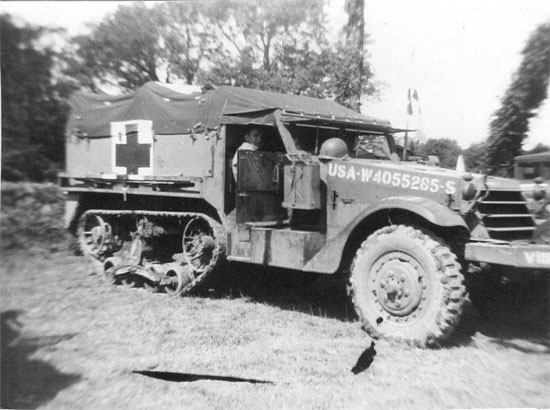
Illustration showing members of the 35th Evacuation Hospital inside an M3 Halftrack which has been equipped for the evacuation of wounded soldiers.
On 28 December 1943 the unit departed Portland, Tennessee for Camp Tyson, Paris, Tennessee (Barrage Balloon Training Center –ed), which served as a Concentration Area for troops alerted for movement overseas. All equipment other than the minimum essentials was turned in for salvage and the personnel underwent the final processing for overseas movement. Over-age men and physically disqualified personnel were removed, and a cadre of 26 Enlisted Men were sent to the 112th Evacuation Hospital. Having fulfilled all T/O requirements, the unit enjoyed the comparative comfort of warm barracks and hot showers at Camp Tyson for one month before departing by train on 1 February 1944 for Camp Kilmer, N. J.
Movement Overseas:
The unit arrived at Camp Kilmer, Stelton, New Jersey, on 3 February 1944 and was due to embark on 10 February from New York Harbor. However, due to bad weather embarking was postponed until 12 February 1944. During the one week period spent at Camp Kilmer (Staging Area for New York Port of Embarkation –ed), all personnel managed to visit New York City at least once, fitting in the activity between training films, lectures, final physical checkups and clothing inspections.
After a 24-hour alert, the heavily-laden command entrained for the docks in New York. Upon arrival and completion of detraining, the men assembled onto a ferry which transported them across the Hudson River. The entire unit personnel finally boarded the Queen Mary at 2010 on 10 February 1944. Right on schedule, the ship pulled out of the docks on 12 February 1944 and started into the Hudson River, past a fog-obscured Statue of Liberty and out into the open sea. The Queen Mary’s crossing of the Atlantic was carried out without escort. The ship was carrying approximately 15,000 troops including one of the largest contingents of Medical troops and WACs ever shipped overseas.
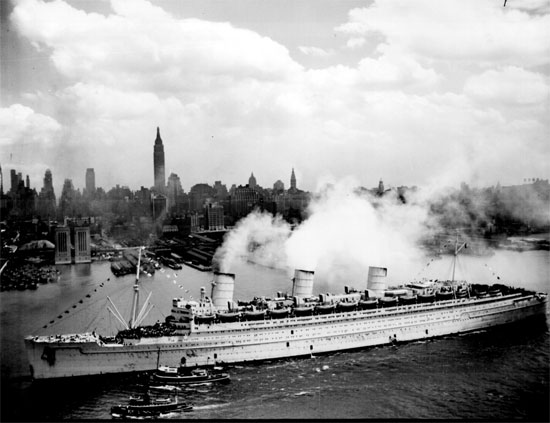
The Queen Mary in her wartime livery sails out of the New York Harbor.
During the beginning of the voyage, the course was set southward, and the weather was warm and pleasant. However, during the northward sailing the weather became increasingly bitter and the seas extremely heavy. Because of the overload of personnel aboard, all Enlisted Men had a bunk below deck every other night, rolling up in their blankets on the promenade deck on other nights. British mess personnel served two meals per day. Meals included kippered herring, and kidney stew both of which proved difficult to negotiate on a slightly seasick stomach! However, for the most part, very few individuals became seasick.
The final leg of the journey brought the ship past the northwest tip of Ireland, the Isle of Man and into the Firth of Clyde, Scotland, where the ship docked at Gourock on 18 February 1944, concluding a seven-day trip across the Atlantic. The troops remained aboard until the following day when they entrained for Stone, Staffordshire.
England:
The unit’s personnel arrived at Stone, Staffordshire at 0300 on 19 February 1944. During stops along the route, troops became acquainted with English coffee, weak tea, and the ever-present call of “Any gum, chum?”
The Hospital’s personnel were billeted by a detail from the 6th Convalescent Hospital which had succeeded in arranging for sundry billets in the village, as well as procuring Meaford Hall for the purpose. The latter also acted as Headquarters for the 35th Evacuation Hospital during its time in England. Despite having more than 20 fireplaces, the historic castle was no more protection against English cold weather than an Iowa barn!
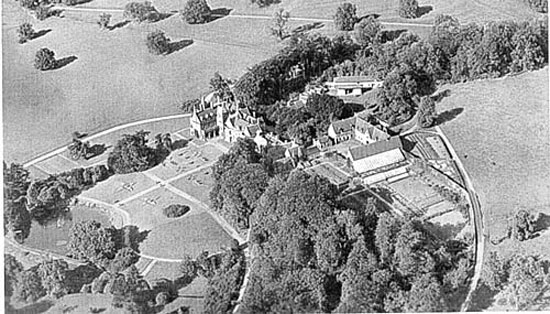
Aerial view of Meaford Hall, which was home to the 35th Evac Hosp during its time in England.
Training and preparation for continental service were completed in England. Personnel were continuously exposed to training films, chemical warfare charts, aircraft models and charts, orientation maps and news extracts. Physical conditioning in the form of hikes, drill and mass athletics were also a major part of the program. It was in England that the beginnings of an excellent softball team were built – a team that was undefeated in England, and rarely suffered defeat in the ETO after V-E Day. Training progressed rapidly for the fast-approaching combat functions of the unit.
Hospital supplies flowed into the outfit in a steady stream from more than 20 Medical Depots located in all sections of the UK. Medical Officers attended the Service School at Shrivenham, and many of the unit’s doctors were placed on DS with US Army General Hospitals and civilian English hospitals. Alongside these preparations, trips were taken by members of the unit to Scotland, London, Chester and to the much-bombed cities of Coventry, Birmingham and Liverpool.
The 35th Evacuation Hospital was alerted for movement across the English Channel on 3 May 1944, but did not actually move from Stone, Staffordshire to the Marshaling Area at Southampton until 18 June 1944. Immediately, the advance party comprising 6 Officers, 50 Enlisted Men and 22 heavily-laden vehicles, boarded a ship which was to sail in convoy to Omaha Beach, Normandy.

Group of Medical Corps and Army Nurse Corps Officers of the 35th Evacuation Hospital. Courtesy Larry Langston.
France:
The advance party’s convoy arrived at Omaha Beach on 19 June 1944. However, the echelon was forced to site out in the water for five days due to inclement weather, which made a landing unfeasible. During this period, the beach and bay were under constant nightly aerial bombardments from German aircraft. The second echelon of the unit which included the remainder of its personnel (except Nurses) left the Marshaling Area at Southampton on 22 June 1944, and arrived at Omaha Beach the following day.

Aerial view of the 35th Evacuation Hospital set up in the field somewhere in France. Unfortunately, exact location and date are unknown.
The Nurses arrived on 24 June 1944, and D+17 and D+18 were spent in bivouac in the immediate beach area. The unit was introduced to the efficacy of the ‘foxhole’ while awaiting orders. Upon arrival of the organization’s Nurses, all echelons were assembled and orders received from the First US Army Surgeon to proceed by motor convoy to St-Sauveur-le-Vicomte. This movement carried the unit through such badly-damaged Norman villages as Isigny-sur-Mer, Carentan, Sainte-Mère-Église before finally arriving at the destination.
Bailey Bridges at Carentan and St-Sauveur-le-Vicomte, which was under strong counter-attack, were under fire from German 88s, resulting in one truck being damaged by shell fragments. There were, however, no casualties from the unit and the Hospital was able to set up the following day three miles northwest of St-Sauveur-le-Vicomte on the Bricquebec route. The unit finally opened to receive patients at 1200 hours on 25 June 1944.
At this location, the 35th Evacuation Hospital supported Seventh Corps’ drive to take the strategic Port of Cherbourg. Despite the fact that this was the 35th’s first taste of ‘the real thing’, in 7 days the unit admitted 1,217 patients, performed 523 major surgical operations and took 848 radiographs.
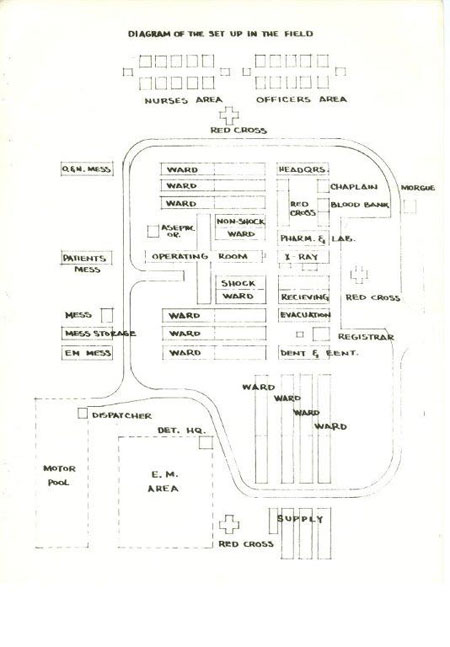
Diagram showing the set up of the 35th Evacuation Hospital in the field.
The Hospital then moved location to the key city of Carentan where it opened on 18 July 1944, although by this time the enemy was no longer on both sides of the unit. Cherbourg had been liberated by the 9th Infantry Division and the main line of resistance lay to the south of Carentan. Here the Hospital admitted some 810 patients, and the serious type of casualty is indicated by the 545 surgical operations which were performed. The unit, still operating under Seventh Corps, First United States Army, supported the drive along the La Haye-du-Puits, Lessay, St-Lô line, remaining in operation at Carentan until the breakthrough at St-Lô. Hospital personnel saw their first great display of Allied air power during the 2,000-planes bombardment of the St-Lô sector, which preceded the Allied breakthrough.
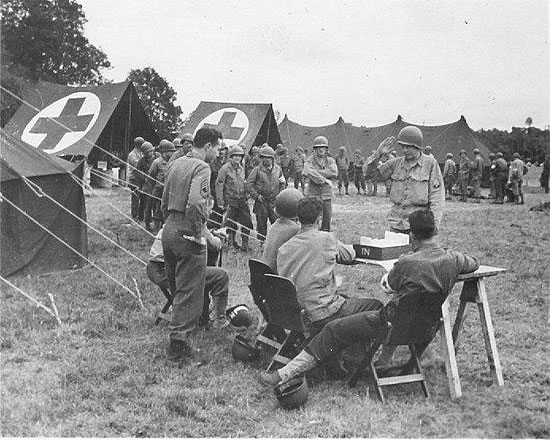
Illustration showing general clerical work at the installation in France. Note the large red crosses and white fields painted on the fly sheets in the background.
In total, the 35th Evacuation Hospital spent 41 days in Normandy in constant operation, earning its first battle star. The unit was then moved from Carentan to Rennes, Brittany, after an all-night ride in 2 ½-ton 6×6 trucks. Third US Army had been committed to action following the breakthrough at St-Lô and in the latter days of July, Patton’s tanks with the 4th and 6th Armored Divisions, under Eighth Corps, had dashed to Coutances, Avranches, and finally liberated the historic capital of Brittany, Rennes, on 3 August 1944.
The organization went into operation at Rennes on 5 August 1944, caring for some 600 liberated Allied Prisoners of War, most of whom were in bad physical condition. Many of these PWs had been hospitalized since the African Campaign; some since the Dieppe Raid. They required a tremendous amount of care. A high percentage were othopedic cases and the casts were found to be maggot-infested, posing an enormous task for the Hospital’s department.
Despite the fact that the main line of resistance manned by the 8th Infantry Division ran by the front door of the Hospital, the citizens of Rennes felt secure in their liberation and gave the unit its first, official welcome to France. However, it could not stay long to enjoy the festivities. Following TUSA’s dash across France, the Hospital was moved rapidly to Villaines-la-Gonais, Machault, and then a long move to Azannes-et-Soumazannes. Casualties were light during these fast-moving stands and individuals in the unit had the occasion to take fast truck trips to surrounding large cities, including Fontainebleau and Paris.
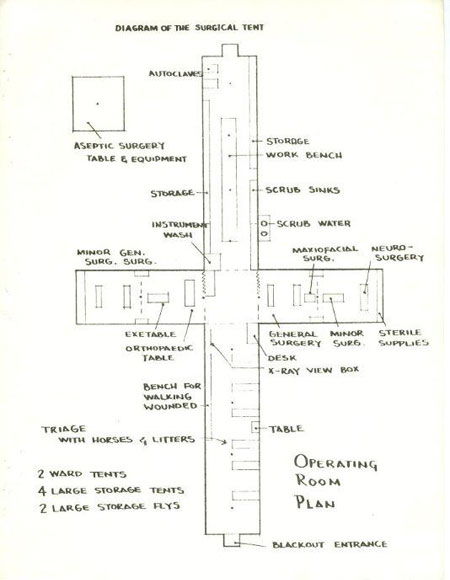
Illustration showing the proposed plan for the Operating Room of the 35th Evacuation Hospital.
After supporting the left flank of Twelfth Corps area at Verdun, the organization took a long move to Drouville, crossing the Moselle River at Nancy on 22 September 1944. The location became untentable on or about 26 September 1944 and the unit moved to buildings for the first time in Nancy, across the Moselle. Overstretched supply lines had blunted the American armor spearheads and the Armies were forced to stop and regroup before renewing the offensive. Hospital personnel were located in the Hôpital Villemin, Nancy on 27 September 1944, in preparation for another long stand. During this period, the 35th Evac admitted its largest number of combat casualties; 4,899. It performed a total of 2,479 major surgical operations and procedures, and took some 8,711 radiographs.
In bitterly cold weather, the 35th Evacuation Hospital moved through the Maginot Line to a former German Army barracks building near Teting-sur-Nied and Saint-Avold on 2 December 1944. The stay here was brief, and the unit admitted 1,462 patients.
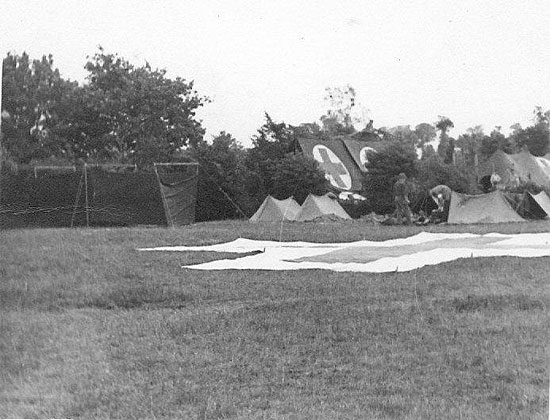
General view of the 35th Evacuation Hospital in the field. Notice the Latrine Screens on the left hand side of the picture, as well as the large Geneva Convention aerial recognition marker on the ground.
Grand-Duchy of Luxembourg:
On 22 December 1944, the unit followed Third United States Army over the to the Metz-Luxembourg salient where it had rapidly moved to hold the right flank of the “Battle of the Bulge.” The Hospital spent a cold Christmas in bivouac at Metz, moving to buildings and finally to operation at Luxembourg City on 28 December 1944. All equipment was moved to the Ecole Primaire de Bonnevoie (Primary School –ed) after removing all of its furnishings to make room for the Hospital. The Hospital was finally opened at 1500. It was during this time that the unit was awarded its third battle star for its participation in the Battle of the Bulge.

Patients are evacuated from the 35th Evacuation Hospital via ¾-ton Ambulances.
During the Ardennes Offensive, a total of 6,505 seriously-injured battle casualties were admitted to the 35th Evacuation Hospital, and a total of 3,110 surgical operations were performed by the unit’s surgical teams and OR staff.
Germany:
Shortly after TUSA’s surprise crossing of the Rhine River, a reconnaissance party was out looking for a new site. The 109th Evacuation Hospital was the first Hospital to open after crossing the Rhine. This was largely due to the problems of the 35th in evacuating 400 German patients from a Hospital in Darmstadt so that American troops might use the building. Early April, an advance party took all the field equipment not in use and moved to Bad Salzungen, near Bad Hersfeld and proceeded to pitch all the tentage. On 12 April 1945, the organization moved into the field and the transition from buildings to the field was facilitated by having the necessary tents already prepared.
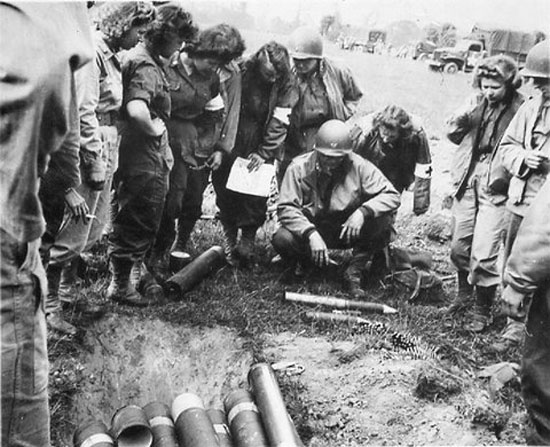
Officers and Nurses of the unit examine unused ordnance and containers. 1st Lieutenant Mary F. Krebehenne from Ohio can be seen on the right. Info courtesy Larry Langston.
On 26 April 1945, the unit moved to Schloß Schönbrunn. Here, the casualties were light. When word that the Germans had surrendered unconditionally reached the Hospital, great relief was felt by all and the Chaplain held a thanksgiving service. Despite this fact, operations still continued, but at a less rapid pace, caring for the sick and injured. On 19 May 1945, a move to Würzburg was anticipated, but the Hospital moved to a field near Forchheim close to Erlangen where the unit continued to function.
The 35th Evac Hosp was put into Category II, and was to be sent to the China-Burma-India Theater (CBI) via the ZI. Many Officers, Nurses and Enlisted Men volunteered to accompany the unit on this move. However, on 3 June 1945 the Hospital moved to a School building in Erlangen where it continued in operation without a break in admitting.
The unit was alerted early August for overseas duty and moved into the field to be relieved of hospital duty and prepare for the trip to Reims, the Concentration Area (with many “City” Camps –ed) for medical units. The personnel entrained for the Concentration Area on 17 August 1945, but the Japanese surrender was received during the journey and so the orders were cancelled.
The End:
With a change in plans, the unit was sent back to duty and went to Garmisch-Partenkirchen, arriving on 6 September 1945. The majority of the Hospital’s personnel was eligible for release and by the end of August all of the original members had been transferred to units returning to the United States, thus leaving the 35th to care for the sick and injured of the Occupation Forces.

A surgical procedure is carried out in the field at the 35th Evacuation Hospital.
As of 10 August 1945 the organization had processed 27,051 patients, performed 11,674 surgical operations, taken 38,012 radiographs. It had been in operation 311 days, and earned battle stars for the following Campaigns: Normandy, Northern France, Rhineland, Ardennes-Alsace, and Central Europe.
Individuals of the unit were also distinguished as there were 2 awards of the Legion of Merit, and 19 awards of the Bronze Star Medal.
Staff of the 35th Evacuation Hospital:
| Commanding Officer | Col C. A. Best (MC) |
| Executive Officer | Lt Col T. T. Stander (MC) |
| Chief Nurse | Capt Mamie A. Twifor (ANC) |
| Adjutant | Lt Donald W. Beck (MAC) |
| Sergeant Major | M/Sgt Claude E. Thomas |
| Chief Clerk | M/Sgt Edwin G. Bushnell |
| Registrar | Maj Maurice E. Clark (MAC) |
| Chief Clerk | T/Sgt Julius A. Lynn |
| Detachment Commander | Maj Charles L. Bowers (MAC) |
| First Sergeant | 1/Sgt Benjamin A. Adams |
| Company Clerk | Sgt William M. Walters |
| Supply Officer | Capt Robert W. Owens (MAC) |
| Supply Sergeant | T/Sgt Lambert N Franke |
| Mess Officer | Lt Robert C. McFadden (MAC) |
| Motor Officer | Lt K. M. Rutherford (MAC) |
| Mess Sergeant | S/Sgt Joseph E. Case |
| Motor Sergeant | S/Sgt William M. Aperdt |
| Chief of Surgical Service | Lt Col Russel L. Malcom (MC) |
| OR Section Chief Nurse | Lt Cora L. Fulford (ANC) |
| OR NCO | S/Sgt John R. Grimes |
| Chief Lab and Pharmacy | Maj Sidney Cohen (MC) |
| Chief Lab Technician | T/Sgt Same T. Beyers |
| Chief Pharmacist | T/3 Dr Robert L. Citron |
| Radiologist | Capt Robert W. Lackey (MC) |
| Chief X-Ray Technician | S/Sgt Rufus R. Wilz |
| Chief of Medical Service | Lt Col George W. Hebard (MC) |
| Ward Section Chief Nurse | Lt Lois H. Griffith (ANC) |
| Ward Section NCO | S/Sgt Osborn J. Stout |

Cover of vintage booklet covering the History of the 35th Evacuation Hospital in the European Theater of Operations.
Personnel Roster (incomplete):
(Male Officers & Enlisted Men):
| Adams, Roscoe W. | King, James M. |
| Agus, Haim | Kingston, Arthur |
| Antoniadis, James | Klushie, Joseph W. |
| Arendt, William M. | Knowlton, Franklin |
| Atterbury, Peyton | Kohl, Howard |
| Bastings, Theodore | Kromphardt, Ralph |
| Battaglini, Armond M. | Lackey, Robert W. |
| Beardsley, Arthur B. | Lang, Thomas |
| Beck, Donald W. | Langston, Robert W. |
| Blake, Edward M., Jr. | Lombardi, Salvadore L. |
| Blankinship, Keith | Lynn, Julius A. |
| Bottrill, Edwin W. | Mackey, Drayton |
| Bowers, Charles L. | Mattocks, Julian O. |
| Brest, Perry D. | McFadden, Robert C. |
| Bump, S. C. | Mills, Hubert E. |
| Burns, Bob | Morrissey, Thomas |
| Bushnell, Edwin G. | Muskett, Francis |
| Castrechino, John | Neschlebra, Albert J. |
| Citron, Robert L. | Nocero, Joseph |
| Clark, Maurice E. | Orszewski, Walter J. |
| Cohen, Sidney | O’Shaughnessy, Robert |
| Cortez, Domingo | Osowski, Albert |
| Crandall, Elton, Jr. | Osterfard, Robert P. |
| Davis, Darrell W. | Owens, Robert W. |
| Derouin, John A. | Packer, Steve |
| DeWolfe, William F. | Partain, Lawrence E. |
| Eberhart, John | Paletta, Francis |
| Echols, John E. | Pelletier, Raymond A. |
| Elcannes, Harold |
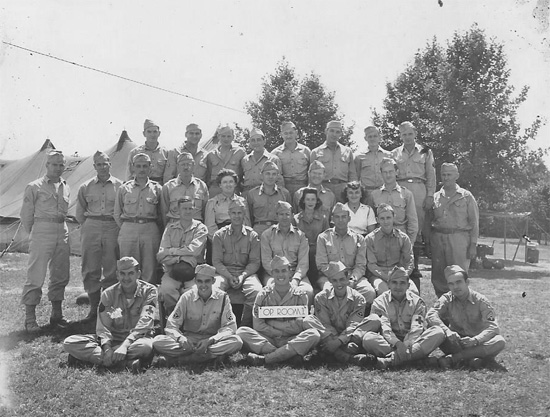
Group photograph illustrating staff of the 35th Evacuation Hospital’s Operating Room.
Courtesy Mike Smith.
| Endly, Herbert M. | Petersen, Gordon W. |
| England, William T. | Pravitz, Carl |
| Ferraro, Al | Prewitt, Floyd C. |
| Festag, Warren | Price, Bernard |
| Florke, Nick | Ratajesak, Otto H. |
| Freundorfer, Francis K. | Reddin, Daniel W. |
| Freyn, William | Ripley, Frank W. |
| Gaynes, Frank | Risedorph, Paul R. |
| Geckler, John H. | Ross, William |
| Geha, Henry | Sabolowski, Joseph |
| Gianni, Ange | Scheckner, Samuel |
| Gray, Howard R. | Smith Charles T., Jr. |
| Gregg, Ward J. | Snyder, Edward |
| Gresko, Joseph | Stein, Sam |
| Grimes, John R. | Stevenson, Edward L. |
| Gugliotti, John R. | Stubbe, Frederick J. |
| Havrilka, Charles | Sweitzer, Sigmund |
| Helsabeck, Belmont A. | Swift, Frederick J., Jr. |
| Hendershot, Virgil E. | Thompson, Joseph R. |
| Hendrickx, Henry | Thorndike, John A. |
| Herman, Warren F. | Thorne, Harry M. |
| Holman, Bernie | Thorpe, Raymond |
| Howard, Wayne | Tomnay, Regis J. |
| Hutchinson, Holstead | Vitale, Fred |
| Inman, George | Waycaster, Hoyt |
| Jaros, Michael | Wedeking, Kenneth |
| Jewel, Francis M. | Williams, John H. |
| Johnson, Pierce R. | Wilz, Rufus R. |
| Kennett, Thomas | Wolff, Herman |
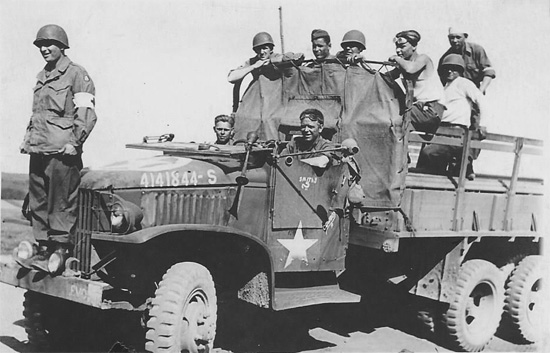
Medical staff and Hospital personnel pictured entrucked on one of the 35th’s 2 1/2-ton Cargo Trucks.Courtesy Mike Smith.
(ANC Officers):
| Barnhardt, Dorothy | Jarrett, Shirley |
| Bartholomew, Violet | Judkins, Corace |
| Benefield, Jennie P. | Kappes, Theophilia J. |
| Blything, Helen | Keffer, Garnet |
| Burbank, Dorothy | Krebehenne, Mary F. |
| Coen, Florence | Lencek, Marie L. |
| Corkum, Barbara | Letourneau, Alice |
| Congiu, Angelia | Leuky, Audrey |
| Cox, Gena | McGee, Marie |
| Dasco, Sue | Marcum, Mary |
| Day, Thelma | Newell, Phyllis |
| Dee, Agnes | Peck, Pauline |
| Dumas, Arlene | Penn, Martha |
| Fulford, Cora L. | Pickett, Mary C. |
| Funk, Phyllis K. | Prossick, Mary |
| Griffith, Lois H. | Rosner, Barbara |
| Hagen, Dorothy | Stevens, Virginia |
| Hancock, Gertrude | Sutherland, Dorothy |
| Hatfield, Josephine | Tederick, Olive |
| Hathaway, Ann | Twiford, Mayme |
| Hess, Ruth | Wage, Norma |
| Hoak, Rosemary | Williams, Jean |
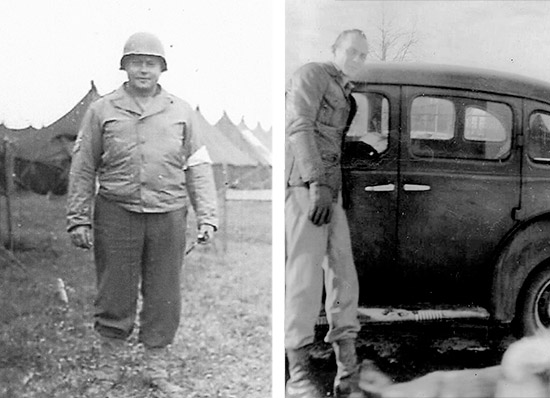
Colonel C. A. Best (L) CO, 35th Evacuation Hospital. Staff Sergeant Robert W. Langston (R). Courtesy Larry Langston.
The authors would very much like to thank Gail Cales, daughter of 1st Lieutenant Marie K. Lencek (ASN:N-767769) who served as a member of the Army Nurse Corps with the 35th Evacuation Hospital during WW2. Gail kindly provided a number of historical documents and photographs which made editing of this Unit History possible. We would also like to extend our thanks to Mike Smith, nephew of Technician 5th Grade Charles T. Smith, Jr. (ASN:35403631) who also served with the 35th Evacuation Hospital. Mike kindly forwarded numerous documents, including a partial personnel roster, received via Army Nurse Corps member Mary C. Pickett. More thanks are due to Larry & Vicky Langston, children of 1st Lieutenant Mary F. Krebehenne (ANC: N-767400) and Staff Sergeant Robert W. Langston (ASN:14013754) of the 35th Evacuation Hospital, for offering some vintage photos to the MRC Staff.
